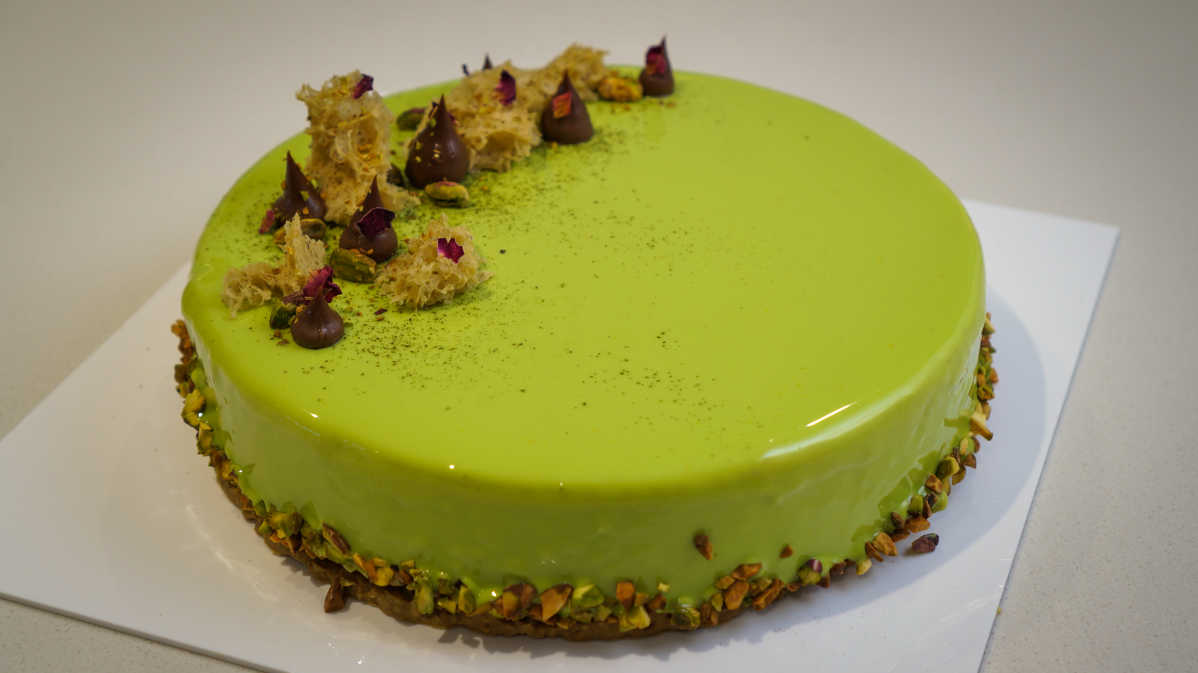Dacquoise
Nutty and light with a delicately crispy exterior

Published: July 10th, 2021 | Last Updated: July 24th, 2021
The dacquoise is a nutty and biscuity sponge. It is used as layers in a cake, as an insert in a mousse cake or entremet or as the base of our One-Bites.
A dacquoise is nutty, airy, has a slight chewiness and a delicate crispy exterior. It is like a macaron, as it is also made by folding ground nuts and sugar through a meringue, however it is not as finicky as a macaron and it looks a little more rugged. The dacquoise provides lightness to desserts and a nice alternative to a sponge and provides a different texture and mouth-feel.
It can be stored at room temperature or frozen.
Ingredients
There are many variations of a dacquoise recipe. They all use the same base but use different nuts.
Almond Dacquoise
The almond dacquoise is the go-to version of dacquoise. It pairs well with a variety of flavours and almond meal is generally the cheapest and easiest type of nut meal to find.
- 70g caster sugar
- 200g egg whites
- 200g icing sugar
- 180g almond meal
Hazelnut Dacquoise
The hazelnut dacquoise is the same recipe, just swapping almonds for hazelnuts. The hazelnut taste is still quite subtle, but worth it if you are going for that hazelnutty flavour.
- 70g caster sugar
- 200g egg whites
- 200g icing sugar
- 180g hazelnut meal
Black Sesame Dacquoise
Black sesame brings an earthiness and is good to balance out sweeter flavours such as caramelised white chocolate. We use almond meal in combination with the black sesame powder for a better texture and rounder flavour.
- 70g caster sugar
- 200g egg whites
- 200g icing sugar
- 90g almond meal
- 90 black sesame powder
Coconut Dacquoise
This coconut dacquoise is a great pairing for tropical flavours. Using shredded coconut also changes the texture and give the dacquoise an interesting bite.
- 70g caster sugar
- 200g egg whites
- 200g icing sugar
- 115g shredded or desiccated coconut
- 65 almond meal
Special tools and equipment used
Stand mixer
The stand mixer in this recipe is used to make the meringue. In general, it is a great tool to help you do something in parallel (since there’s often lots to do when making desserts!).
The stand mixer is an investment, but it is used in countless dessert applications such as meringues, cake and cookie batters and choux pastry. We recommend a good quality stand mixer such as this one which will last through years of dessert making.
Method
1. Preheat the oven to 180°C.
2. Sift the nut meal and icing sugar together. (Tip: A drum sieve is the quickest way to sieve)

3. Beat the egg whites on medium speed in a stand mixer with the whisk attachment. When the egg whites are mostly foamy and white, gradually add the caster sugar. Continue beating to form a meringue until it is able to hold a stiff peak. Be careful not to over whip!


4. Fold the meringue into the sifted mixture until evenly combined, being careful not to deflate the mixture.


5. Spread the mixture with an offset spatula onto a lined baking sheet into a layer about 1.5-2cm thick. Try to make sure the surface is evenly thick and the sides are clean so that it bakes evenly and to avoid burning.


6. Bake for 30 minutes or until the middle is golden brown. It may require a slightly longer or shorter time depending on your oven. The time also varies depending on how much you make and how thick the mixture is spread to.


7. Once golden, allow to cool completely at room temperature. The mixture may deflate a little, but that’s okay!
8. Cut into desired shapes.





Get the latest recipes and insights!
Subscribe to our mailing list for the latest dessert recipes, tips and advice.





